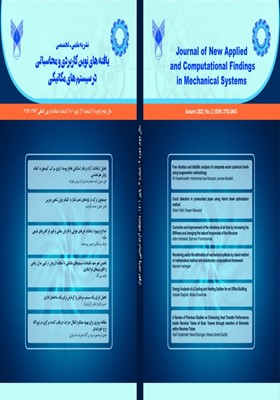تخمین عمر مفید باقیماندۀ سیستمهای مکانیکی با استفاده از روش ترکیبی مدل ریاضی و الگوریتمهای فراابتکاری
محورهای موضوعی : یافته های نوین کاربردی و محاسباتی در سیستم های مکانیکی
1 - 1گروه ریاضی، واحد آبادان، دانشگاه آزاد اسلامی، آبادان، ایران
کلید واژه: الگوریتمهای تکاملی, تخمین عمر مفید, شبکههای عصبی مصنوعی, پنجرۀ زمانی متحرک,
چکیده مقاله :
پیشبینی دقیق از عمر مفید باقیمانده تجهیزات مکانیکی، برای تعمیـرات و نگهداری وسایل ضروری است. تاکنون الگوریتمهای دادهمحور زیادی ارائه شده است و نتایج خوبی در زمینه عیبیابی پیشگویانه حاصل شده است. در این مقاله با استفاده از الگوریتم فرا ابتکاری، بهینهسازی پارامترهای مربوطه انجام میشود، بهطوریکه از پنجره زمانی متحرک بههمراه مدل ریاضی استفاده میشود. تنظیم پارامترهای مرتبط با دادهها در چارچوب بهینهسازی، اجازه استفاده از مدلهای ساده مثل شبکههای عصبی با تعداد کمی لایه پنهان و تعداد کمی نورون در هر لایه را میدهد که در محیطهایی با منابع محدود نظیر سیستمهای تعبیهشده قابل استفاده هستند. برای ارزیابی کارایی روش ارائه شده پیشنهادی، از شاخص امتیازدهی ریشه میانگین مربعات خطا و امتیاز سلامت عمر مفید استفاده شده است. بدین منظور مجموعه دادههای تصادفی در نظر گرفته شده است که نتایج آن عمومیت و خاصیت مقیاسپذیری آن را نشان میدهد. با وجود استفاده از رگرسورها و الگوریتمهای تکاملی خاص در این مطالعه، ترکیبهای زیاد دیگری نیز امکانپذیر است و ممکن است برای کاربردهای متفاوت مناسبتر باشند. بهعلاوه این چارچوب عملاً برای ساخت مدل، یعنی ایجاد بهترین معماری شبکه عصبی ممکن متناسب با یک کاربرد خاص، قابل استفاده است.
An accurate prediction of the remaining useful life of the equipment is necessary for use, repairs and maintenance. Useful life prediction has been widely used, while the data obtained from it is not functional in different conditions. Many data-driven algorithms have been proposed and good results have been obtained in the field of predictive troubleshooting. Therefore, in this article, the relevant parameters are optimized using the meta-heuristic algorithm, so that the moving time window is used along with the mathematical model. Setting parameters related to data in the optimization framework allows the use of simple models such as neural networks with a small number of hidden layers and a small number of neurons in each layer, which can be used in environments with limited resources such as embedded systems. To evaluate the effectiveness of the proposed method, the root mean square error scoring index and useful life health score have been used. For this purpose, a random data set has been considered and the results show the acceptability of the method.
[1] Liu, R., Ryan, J. K. (2005). Residual-life distributions from component degradation signals: a Bayesian approach. IEEE Transactions, 37(6), pp 543–557.
[2] Lee, J., Wu, F., Zhao, W., Ghaffari, M., Liao, L., Siegel, D. (2014). Prognostics and health management design for rotary machinery systems - Reviews, methodology and applications. Mechanical Systems and Signal Processing, 42(12), pp 314–334.
[3] Lim, P., Goh, C. K., & Tan, K. C. (2016). A time window neural networks based framework for remaining useful life estimation. In Proceedings international joint conference on neural networks , pp 1746–1753.
[4] Peng, Y., Wang, H., Wang, J., Liu, D., Peng, X. (2012). A modified echo state network based remaining useful life estimation approach. In IEEE conference on prognostics and health management , pp 1–7.
[5] Qian, Y., Yan, R., Gao, R. X. (2017). A multi-time scale approach to remaining useful life prediction in rolling bearing. Mechanical Systems and Signal Processing, 83, pp 549–567.
[6] Jones, E., Oliphant, T., Peterson, P. (2001). Scipy: Open source scientific tools for Python. URL http://www.scipy.org/. [Online; Accessed 06/2018].
[7] Parmeshwaran, V. (2004). Residual life distributions from component degradation signals: A neural-network approach. IEEE Transactions on Industrial Electronics, 51(3), pp 150–172.
[8] Benkedjouh, T., Medjaher, K., Zerhouni, N., Rechak, S. (2013). Remaining useful life estimation based on nonlinear feature reduction and support vector regression. Engineering Applications of Artificial Intelligence, 26(7), pp 1751–1760.
[9] Dong, M., He, D. (2007). A segmental hidden semi-Markov model (HSMM)- based diagnostics and prognostics framework and methodology. Mechanical Systems and Signal Processing, 21(5), pp 2248–2266.
[10] Li, X., Ding, Q., Sun, J. Q. (2018). Remaining useful life estimation in prognostics using deep convolution neural networks. Reliability Engineering & System Safety, 172, pp 1–11.
[11] Sikorska, J. Z., Hodkiewicz, M., Ma, L. (2011). Prognostic modelling options for remaining useful life estimation by industry. Mechanical Systems and Signal Processing, 25(5), pp 1803–1836.
[13] Ramasso, E. (2014). Investigating computational geometry for failure prognostics. International Journal of Prognostics and Health Management, 5(1), pp 1–18.
[14] Storn, R., & Price, K. (1997). Differential evolution – A simple and efficient heuristic for global optimization over continuous spaces. Journal of Global Optimization, 11(4), pp 341–359.
[15] Zhang, C., Lim, P., Qin, A., Tan, K. (2016). Multiobjective deep belief networks ensemble for remaining useful life estimation in prognostics. IEEE Transactions on Neural Networks and Learning Systems, 99, pp 1–13.
[16] Saxena, A., Goebel, K. (2008) challenge data set. [Online] Available at: https://ti.arc.nasa.gov/tech/dash/groups/pcoe/prognostic-data-repository/.
_||_
